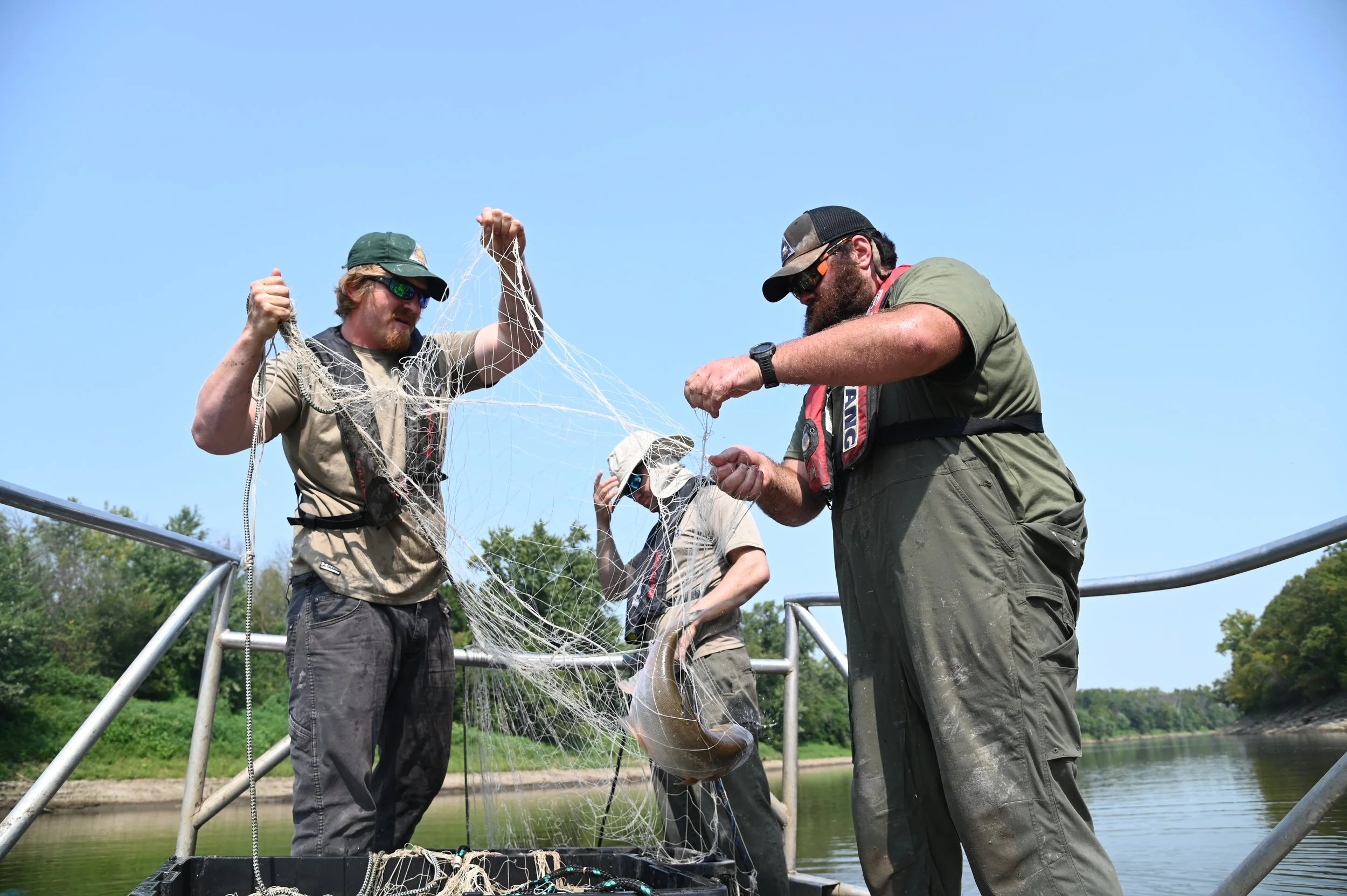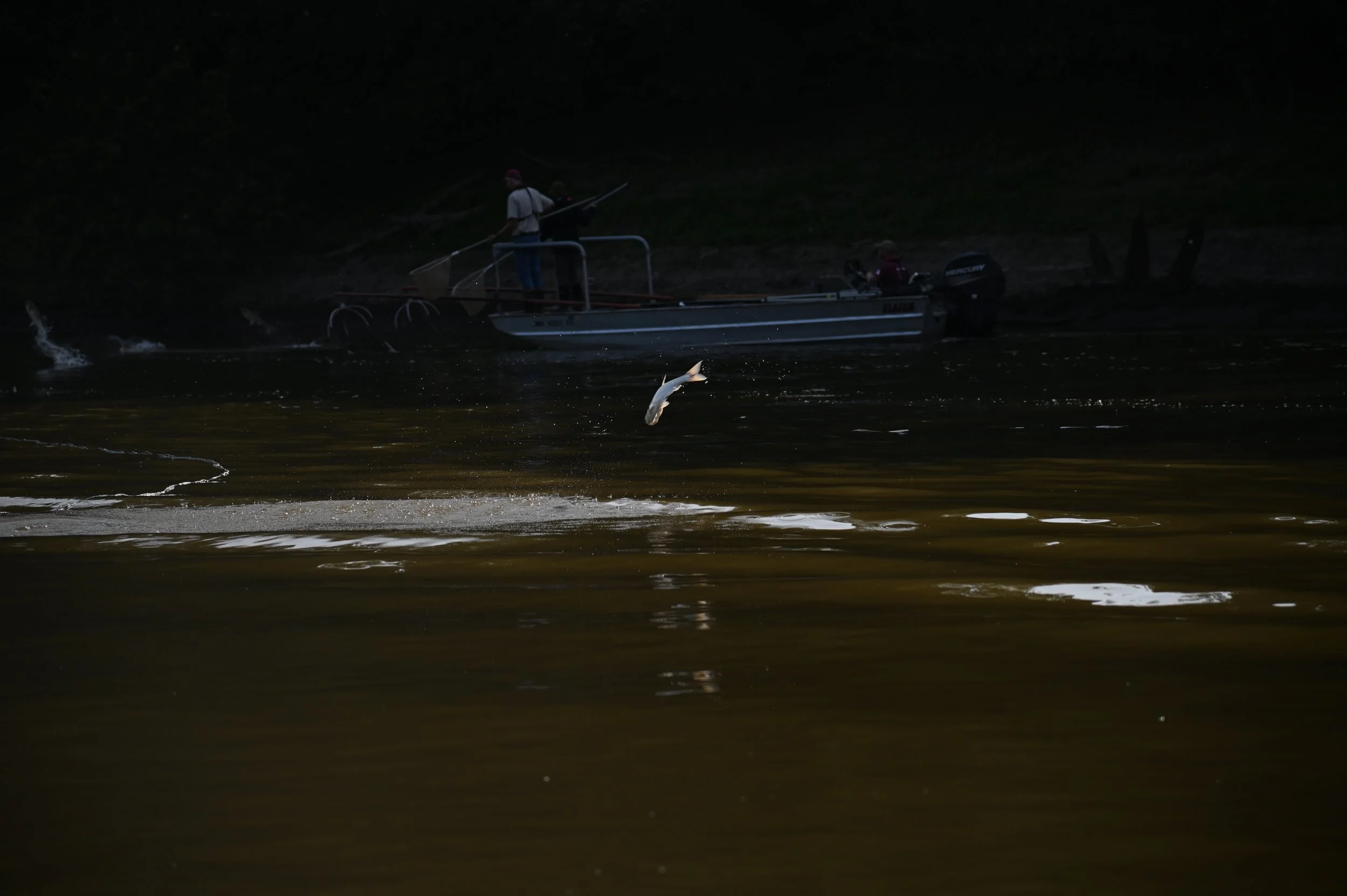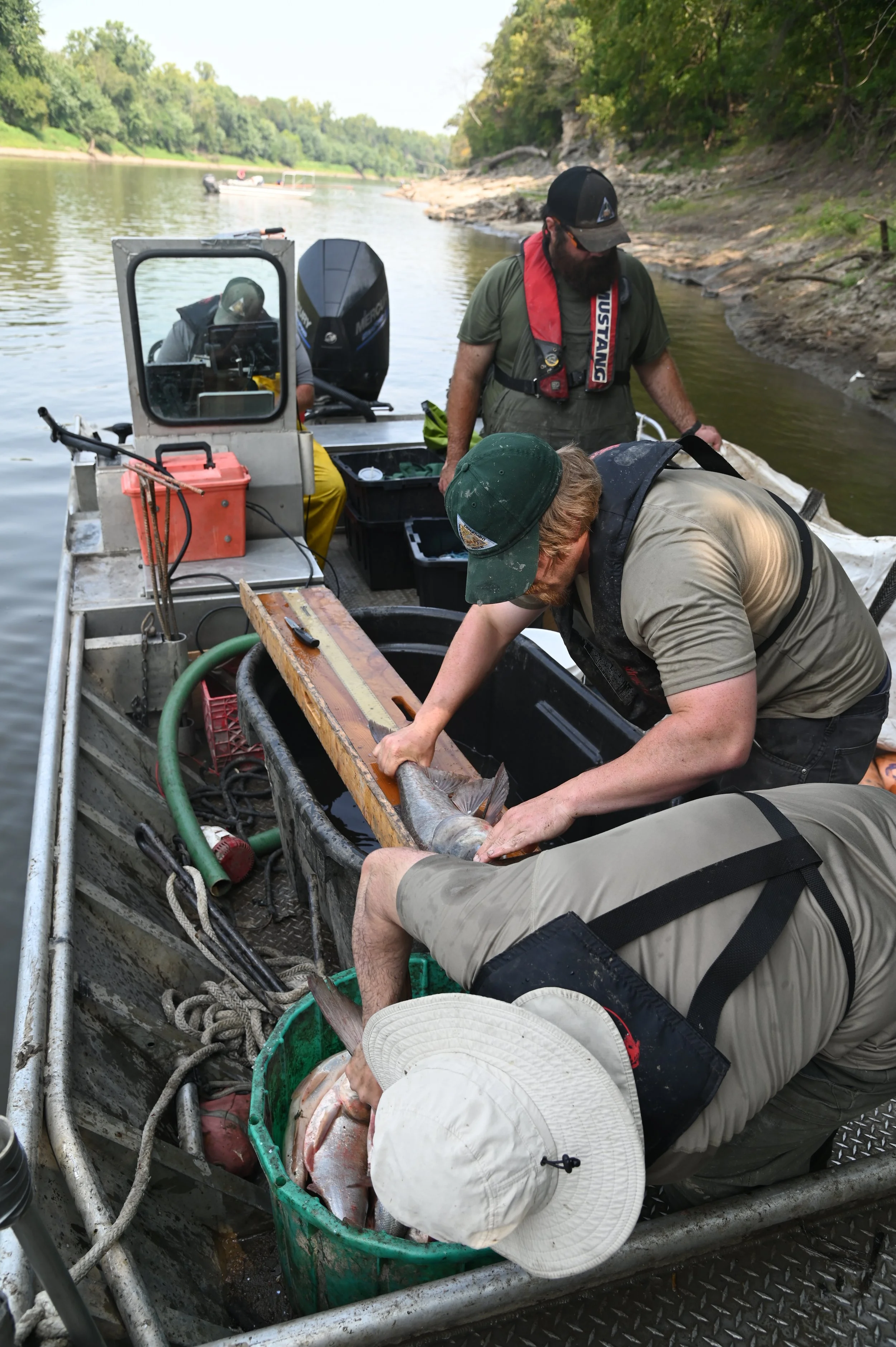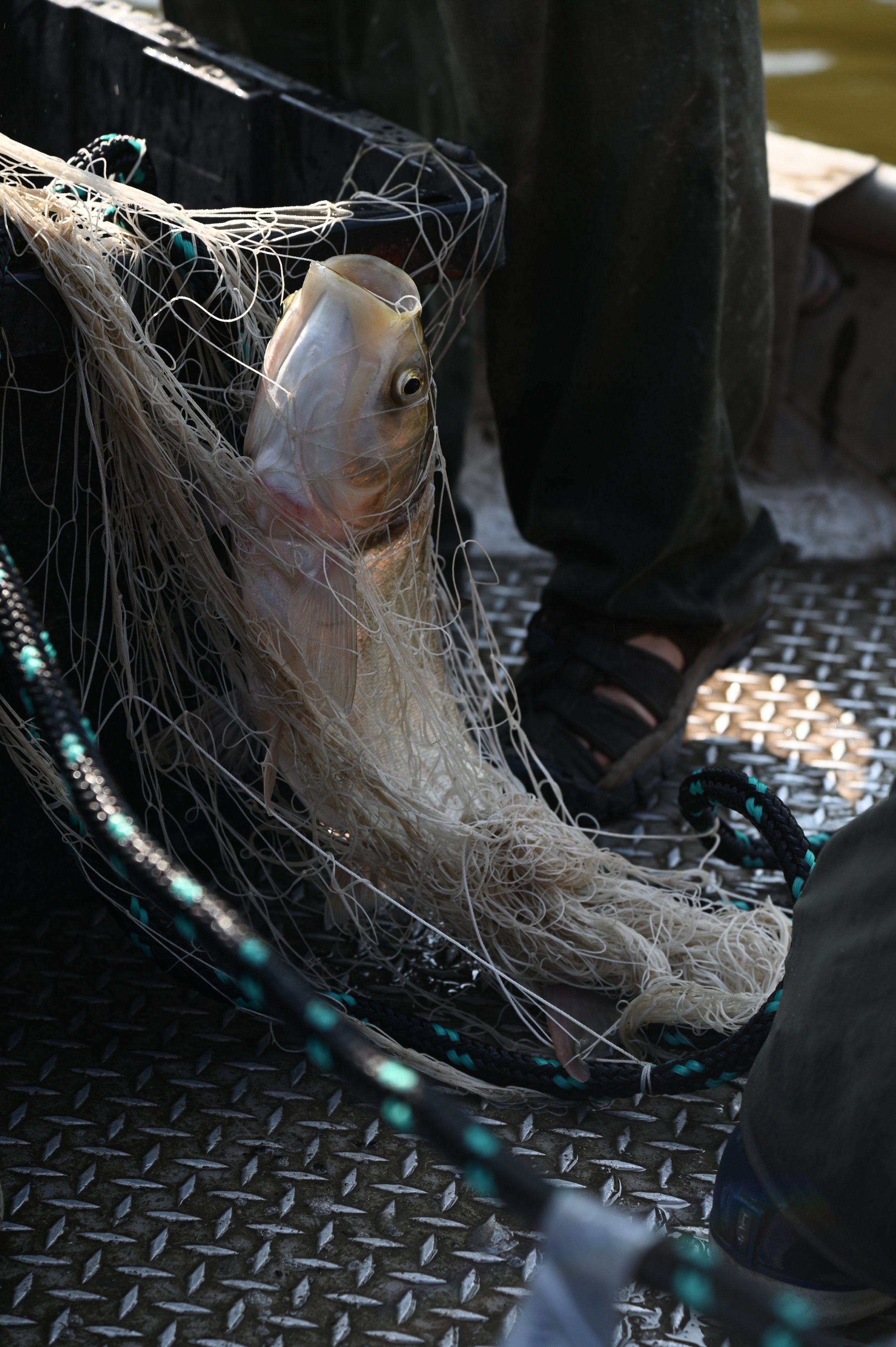Efforts Ramp Up to Combat Silver Carp Threat from Local River
Missouri Conservation workers in partnership with U.S. Fish and Wildlife Service, Kansas Parks and Wildlife Department, and FKF Commercial Fisheries LLC remove 43,401 pounds of silver carp from the Lamine River on September 9th through the 12th and the 23rd through the 26th. This removal effort is similar to the removal effort done on the Grand River in September 2023.
In a bold effort to combat the spread of flying fish, biologists and conservation groups descend upon the Lamine River, aiming to preserve the river’s natural ecosystem, which has been disrupted by the silver carp's rapid reproduction and competition with native fish species. The initiative marks a critical step in the fight to protect Missouri's waterways from the damaging effects of this invasive species.
Silver carp (Hypophthalmichthys molitrix) are perhaps one of the most well-known invasive species in the state of Missouri. Their tendency to jump out of the water garnered them the colloquial name “flying fish.” Their other claim to fame is how invasive they have become in such a short time. After their introduction in the 1970s, they began to reproduce in the basins of the Mississippi and Missouri rivers and are now present in 24 states according to the USGS.
Silver carp are part of a group referred to as Asian carp – bighead, black, grass and silver carp. Together they make up about 95% of the biomass in the water.
Silver carp are particularly a problem in Missouri according to Kasey Whiteman, the Missouri River and Biometrics Unit Supervisor for the Missouri Department Conservation. "We have a very open system compared to other waterways, meaning that we do have some tributaries that are dammed up to make reservoirs and lakes but for the most part our streams and our Missouri River are not dammed up or don't have physical barriers on them,” said Whiteman. “It makes it a very open system which is very good for the native riverine species because they need that ability to move upstream ... but that also allows the silver carp to get into a lot of water bodies that we may not want them to get to.”
Native fish are at a detriment when invasive species like the silver carp come into their habitat. Silver carp are filter feeders, which means they eat by filtering out plankton or nutrients suspended in the water. “They swim around [with their] mouths open in these highly productive, nutrient-rich waters, and they directly compete with paddlefish, with our buffalo species, with gizzard shad, which are all native species that we want to maintain,” said Whiteman.
Whiteman also notes they compete with all species of fish that are at their larval or juvenile stage. The juvenile fish are not developed enough to eat anything other than microscopic species.
The home base for the removal effort on the Lamine was at the De Bourgmont Access in Cooper County. Gill nets, dip nets, electrofishing, and a modified jon boat were all used to catch the silver carp. Two boats deployed gill nets in an ovular fashion. Two or three people in the front of the boat throw the nets out into the water while the boat slowly moves. The fish then get captured in the gill nets. Their heads are small enough to fit through the mesh, but their bodies are not. When they try to back up, the posterior side of their gill cover gets caught. Trying to get out only causes them to get wrapped up.
While the gill nets are deployed, a third boat goes farther up the river and does electrofishing with dip nets. The goal with electrofishing is to attract the fish and temporarily immobilize them so the dip nets can catch them. Another boat with net modifications also goes farther up the river to catch the silver carp. The boats are equipped with traditional, down-scan and side-scan sonar to be efficient in finding aggregations of silver carp to set nets around.
“They [the sonar] are reliable to a point. That’s why we are incorporating the technology during removals to keep learning and fine tuning. We can use the side-scan sonar and hydroacoustic surveys to provide us a better idea what percentage of the population we are actually removing,” said Adam McDaniel, Aquatic Resource Scientist at the Missouri Department of Conservation.
Pre-removal effort, the U.S. Geological Survey used side-can sonar to estimate abundances of silver carp. They did the same thing post-removal effort. In addition, the U.S. Fish and Wildlife Services used hydroacoustic dual beam sonar to estimate densities of silver carp, also pre- and post-removal effort.
After the silver carp are pulled in they are all measured, including native species caught accidently. The measurements taken are used in combination with hydroacoustic assessments to estimate the densities of silver carp in the stretch of river they are focused on. Also, they help to evaluate the overall fish community response to the removal efforts.
Over the course of the removal effort, 43,401 pounds of silver carp and some bighead carp were removed from the Lamine River, making it a huge success.
After the silver carp are removed they are stored in large 44 inch by 48 inch boxes that are hauled by a truck and gooseneck trailer to FKF Commercial Fisheries and Bait in Philadelphia, Mo. There they are kept cold at 30 degrees and then sliced up into six sections. The pieces are then brined with a secret recipe and vacuum sealed to be sold. Stores such as Farm and Home, Shields Outdoors, Bluff City Outdoors, and more sell the bait.
The operation does not want to stop at bait. Darrick Garner, FKF Commercial Fisheries and Bait founder, has ideas to expand to selling fertilizer made with silver carp. Garner stresses the importance of reducing the population of silver carp in Missouri waters and finding ways to utilize the fish either for human consumption or, in his case, bait.
“If we're hitting specific pools, like what Kasey Whiteman was setting up, I do think we can make impacts on certain pools. I truly do,” said Garner.
Missouri Department of Conservation employees, from left, James Stokes, Caleb Bolin and Mason Deja pull in gill nets with silver carp in them near the De Bourgmont Access on the Lamine River in Cooper County, Mo., on Wednesday, Sept. 11, 2024. An estimated 8,000 pounds of silver carp were captured on the first day of the removal effort, with 7,000 pounds the next day, and an approximated 5,000 the third day.
A silver carp jumps out of the water near the De Bourgmont Access on the Lamine River in Cooper County, Mo., on Wednesday, Sept. 11, 2024. Silver carp often get spooked by boat motors and will jump out of the water, putting boaters at risk of being hit.
Along with capturing silver carp, Missouri Department of Conservation employees also measure them near the De Bourgmont Access on the Lamine River in Cooper County, Mo., on Wednesday, Sept. 11, 2024. The measurements taken are used in combination with hydroacoustic assessments to estimate the densities of silver carp in the stretch of river they are focused on.
Missouri Department of Conservation Fisheries Technician Caleb Bolin sets out a gill net on near the De Bourgmont Access on the Lamine River in Cooper County, Mo., on Wednesday, Sept. 11, 2024. The gill nets are designed to allow the fish to put their head through but not their body, getting their gills stuck when they try to back out.
A silver carp is caught in a gill net near the De Bourgmont Access on the Lamine River in Cooper County, Mo., on Wednesday, Sept. 11, 2024. Silver carp are invasive to Missouri and pose a significant threat to native fish species by competing with them for resources, such as feeding on phytoplankton and zooplankton.
Native paddlefish are caught by accident while removing silver carp near the De Bourgmont Access on the Lamine River in Cooper County, Mo., on Wednesday, Sept. 11, 2024. Silver car compete directly with paddlefish for biomass in the river.
Captured silver carp wait to be picked up to become bait near the De Bourgmont Access on the Lamine River in Cooper County, Mo., on Wednesday, Sept. 11, 2024. Over the course of the removal effort, 43,401 pounds of silver carp (and some bighead carp) were removed from the Lamine River, making it a success.






